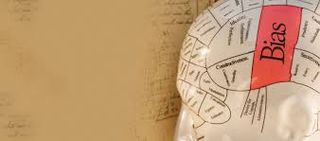Bias
MRIs Reveal Unconscious Bias in the Brain
Shining a light on an elephant in the room.
Posted April 7, 2016 Reviewed by Davia Sills
Luskin's Learning Psychology Series—No. 23
As Chancellor and CEO of the Ventura County Community College District in California, our three colleges educate more than 50,000 students annually for careers, to transfer to various colleges and universities, and to actively contribute to their communities. I work with hiring committees, give advice regarding strategic future possibilities, and work alongside colleagues as we help those we serve to succeed and have better lives in many ways.
Our Ventura County population includes one million residents. It is culturally and economically diverse. As a licensed psychotherapist and school psychologist active in education and professional organizations, including the Society for Media Psychology and Technology of the American Psychological Association, I have the continuing opportunity to learn and stay current on new research on bias, discrimination, diversity, equity, opportunity, and pathways to success for our many students.
The presence of unconscious bias has now been validated through magnetic resonance imaging (MRI), making unconscious bias an increasingly “hot topic” that is heightening awareness and contributing to progress in understanding, diminishing, and even eliminating bias.
My purpose in this article is to provide a simple and clear update of where we are in Ventura County education and to describe some ways we are working to increase sensitivity and broaden awareness of the concept of unconscious bias. My analysis generalizes across the state and nation, but my specific present experience and information come directly from my work in the Ventura County Community College District.
Unconscious Bias
Unconscious bias has been identified, observed, and validated in brain studies using Magnetic Resonance Imaging (MRI) technology. Unconscious bias is now acknowledged by psychologists and neuroscientists as real and measurable.
Understanding the nature of unconscious bias and providing proper staff development helps foster positive and improved responses to diversity and equity in human resources. Training and explaining the reality of unconscious bias, its implications, and how to manage it will now become fundamental in our personnel training and employment selection.
Validating Unconscious Bias
Unconscious bias is measurable, widespread, disassociated from conscious bias, and is now cognitively and quantitatively validated. It is reflected in attitudes or stereotypes that affect one’s understanding, decision-making, and behavior, without consciously realizing it in many instances.
The first step in solving any problem is to recognize its existence. Understanding the science related to identifying and conceptualizing bias helps us to recognize and acknowledge bias and its possible effects. The following discussion reviews many of the scientific factors revealing bias.
Implicit Unconsciousness
Psychologists have identified implicit, unconscious biases. Some can be the result of repeated and pervasive messages that establish and perpetuate stereotypes. We are all biased, whether we are conscious of our stereotypes or not, so we should acknowledge this and strive to understand biases in order to deal with them appropriately. Taking a bias test and looking at neurological responses in an MRI brings this reality home.
The Harvard Implicit Association Test (IAT) measures attitudes and beliefs that people may be unwilling or unable to report. The IAT may be especially interesting if it shows that you have an implicit attitude that you did not know about.
For example, you may believe that women and men should be equally associated with science, but your automatic associations could show that you (like many others) associate men with science more than you associate women with science. Implicit bias determines how you see the world (Harvard Project Implicit). A link to the test is provided in the references below.

Implicit Bias Tests
Racism, sexism, and homophobia are measurable in people who are not consciously aware of racist, sexist, or homophobic responses. Awareness is the first step toward neutralizing these types of bias and desire allows you to manage them.
Repeated exposure with knowledge is a technique that desensitizes and broadens perception, so shining a light on both unconscious and implicit bias is a good cognitive approach.
Unconscious Bias Association Test (listed in references below)
The concept of implicit bias hit the mainstream in 1998, when an unconscious bias assessment went online. Since then, more than 6 million people have taken the Implicit Association Test as a result of collaboration among psychologists at Harvard University, the University of Virginia, and the University of Washington. The various tests' purpose is to create awareness and, therefore, management of unconscious or implicit biases. The point is that even self-professed bias-free egalitarians, who think they have no bias, show bias when MRI comparisons are made.
The Unconscious or Implicit Association Test methodology gauges unconscious prejudice by measuring the speed of making associations. For example, the test can measure how quickly someone pairs a face that reflects their own ethnicity with a positive term and then compares that response time to how quickly that person pairs the face of a person of another ethnicity with a positive term.
Neuroscience has now proven that people were not falsely claiming to believe in equality. Instead, neuroimaging shows that decision-making automatically triggers specific regions of the brain responsible for unconscious processing, including those measured by the Implicit Association Test. MRI imaging showing which regions of the brain are activated during biased responses allows us, i.e., you, to see the occurrence of biased associations, increasing our ability to counter or diminish them. Again, the point is that bias is in place, whether you are aware of it or not, and it can be measured.

The amygdala is an almond-shaped set of neurons deep in the temporal lobe. The amygdala has emerged as a key region of the brain in MRI bias research.
The amygdala is the “emotional” center of the brain that reacts to fear and threat and other senses. Scientists have found a measurable correlation between amygdala activity and implicit racial bias. The point again is that research shows a visual brain response, even though an individual may not be conscious of it.
The amygdala isn’t the only part of the brain involved in unconscious bias. The frontal cortex is also identified as important in forming impressions of others and in measuring empathy. Memories, such as dates and facts, also subconsciously steer people toward choosing one option over another.
Understanding the implications of widespread automatic biases has begun to change diversity programs within education and corporate America. Seeing the results in an MRI takes subjective judgment off the table. One goal, therefore, is to educate people about basic forms of bias that may hinder their judgment so that they can recognize and discard their bias in the interest of achieving equity through knowledge and understanding.
We are a nation of diverse ethnic cultures, generational differences, diverse religious beliefs, sexual orientation, and more. Diversity and equity are now central to our way of life. With unconscious bias now documented, the knowledge that it can be measured means that unconscious bias can and should be substantially eliminated as the elephant in the room in work, school, and life. An MRI can literally shine a light on the bias.
Recently, I participated in a statewide CEO meeting of California Community College Chancellors and Presidents representing California’s 72 community college districts, 113 community colleges, and more than two and one-half million students. The CEOs all expressed interest in understanding and reducing bias as a means to achieve diversity and equity.
This month, we launched a diversity dashboard on our Ventura College Community College District Website so that our many faculty members, students, and citizens have access to our diversity and performance information. We have begun education programs with our faculty and staff to shine a light on diversity for purposes of equity.
My comments here simply offer a discussion as a means of communicating what we now know. Reducing unconscious and implicit bias represent worthy objectives for us all. It will take all of us working together to make progress. I have shared this explanation and these ideas to keep the ball rolling as we work together to diminish unconscious bias in the interest of fairness, equity, and success for each individual and group.
My own focus is on working with faculty and staff at Moorpark, Oxnard, and Ventura Colleges in the Ventura County Community College District to shine a light on bias in the interest of increasing understanding and real equity.
Special thanks to Dr. Toni Luskin and Janeene Nagaoka for editorial and graphics assistance.
Bernie Luskin’s definitions and distinctions between implicit and unconscious bias are:
Implicit bias is the bias in judgment and/or behavior that develops from subtle cognitive processes (e.g., implicit attitudes and implicit stereotypes) that are held and often operate at a level below conscious awareness and may not be recognized.
Unconscious bias refers to a bias that we are unaware of, and that happens outside of our control. Unconscious bias is a bias that happens automatically of which we may not be aware, yet is measurable when examining responses in our brain. The distinctions are subtle, but they are there.
References
Link to Harvard Project Implicit Test:
https://implicit.harvard.edu/implicit/education.html
Link to Unconscious Bias Test:
http://www.itv.com/news/2014-12-11/how-to-take-the-unconscious-bias-tes…




